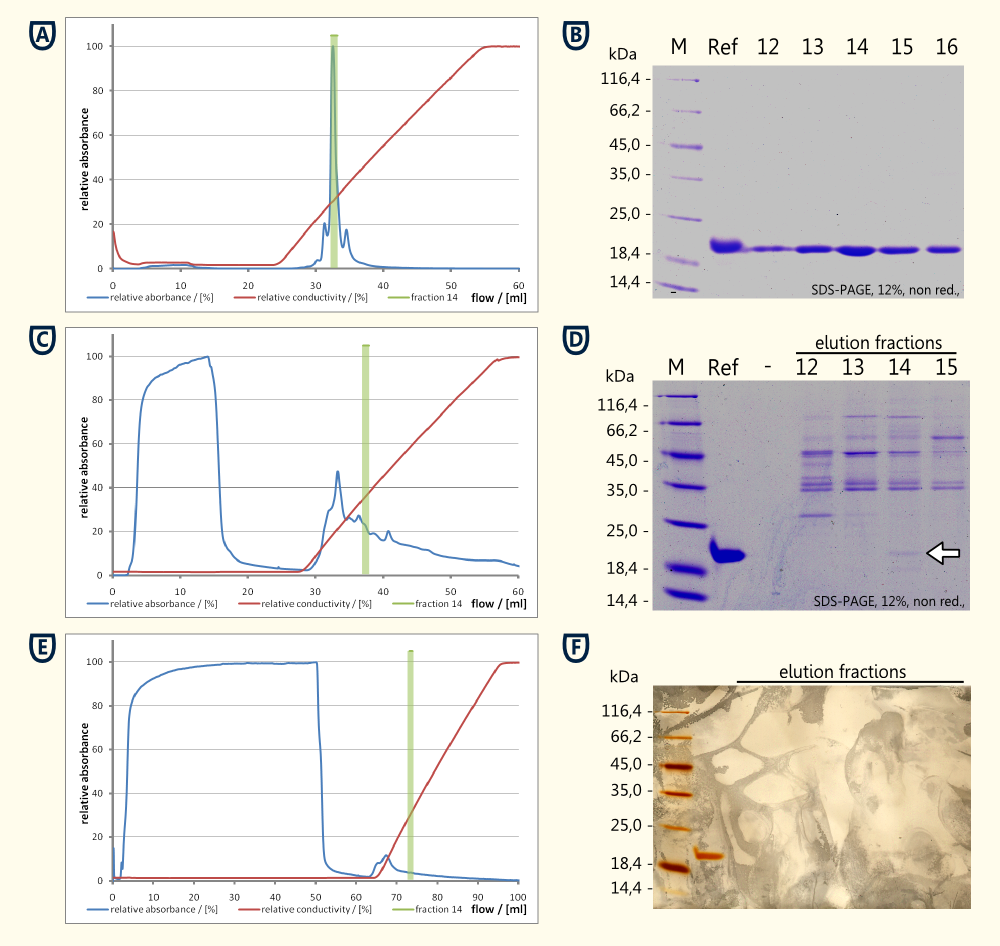Coding
Part:BBa_K801080:Experience
Designed by: Alois Bršuer Group: iGEM12_TU_Munich (2012-09-21)
Revision as of 18:07, 26 September 2012 by Fabian Froehlich (Talk | contribs) (‚Üí‚ÄéIon exchange chromatography)
Expression of Thaumatin
Ion exchange chromatography
Preprothaumatin becomes posttranslationally modified by cleaving a part of the N- and the C-terminal polypeptide. Therefore it was not possible to add a tag for affinity chromatography. For this reason it was necessary to purify the protein from the cytoplasm of the desintegrated yeast cells using ion exchange chromatography to have a proove of principle.
Experimental details:
- Samples: cell lysate, supernatant from culture, reference for thaumatin (MedHerbs)
- Dialysis against 20mM MES Buffer pH 6.0 (twice) using a 12-16 kDa dialysis membrane
- Chromatography with a √Ąkta purifier equipped with a Ressource S 6ml (S: Methyl sulfonate (strong cation exchanger))
- Sample was applied using a super-loop
- Wash with two colum volumes 20mM MES Buffer pH 6.0
- Elution with a gradient of 0 - 500 mM NaCl over 5 column volumes
- Fractions of 1 ml were collected during the elution
Experimental results:
- Reference Thaumatin (see figure A and B)
- nealy no protein in the flow through during sample application (see figure A)
- a major peak eluting at ~14 mS*cm-1 which corresponds to fraction Nr. 14 see figure A)
- The corresponding SDS-PAGE showed a clear band around fraction Nr. 14 corresponding matching the expected 22 kDa
- Cell lysate
- high concentration of protein in the flow through (see figure C and D)
- no clear peak arround fraction 14 could be detected
- The SDS-PAGE performed from the reference and the fractions 12 to 15 showed a weak band at the height of the reference. This band having the same size as the reference (see running propperties on SDS-PAGE in figure D) and the same isoelectric point (both eluted in fraction 14) is very likely to be thaumatin which was produced by the yeast cells.
- Supernatant of yeast culture (see figure E and F)
- Export of the protein in high concentrations was unlikely to happen, therefore 48 ml of supernatant were loaded on the column
- Ratio between frowthrough and eluted protein was less favourable compared to the cell lysate.
- Total protein quantities were to low to be detected by Coomassie stain, therefore a silver stain was performed (see figure F)
- Beside the reference no additional proteinbands could be detected on the silver stained SDS-PAGE
Conclusion from this experiment:
A proof of principle for the expression of Thaumatin was achieved using ion exchange chromotography and comparison of bands optained on an SDS-PAGE relative to a standard of Thaumatin.
Applications of BBa_K801080
User Reviews
UNIQ143ec708b52d3037-partinfo-00000000-QINU UNIQ143ec708b52d3037-partinfo-00000001-QINU

